Home » Rocks » Sedimentary Rocks » Coal
Coal
What Is Coal and How Does It Form?
Article by: Hobart M. King, PhD, RPG
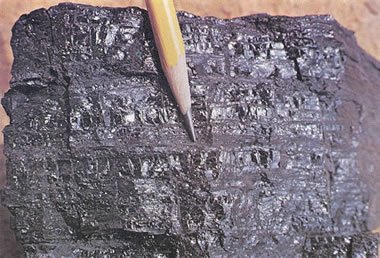
Bituminous Coal: Bituminous coal is typically a banded sedimentary rock. In this photo you can see bright and dull bands of coal material oriented horizontally across the specimen. The bright bands are well-preserved woody material, such as branches or stems. The dull bands can contain mineral material washed into the swamp by streams, charcoal produced by fires in the swamp, or degraded plant materials. This specimen is approximately three inches across (7.5 centimeters). Photo by the West Virginia Geological and Economic Survey.
What is Coal?
Coal is an organic sedimentary rock that forms from the accumulation and preservation of plant materials, usually in a swamp environment. Coal is a combustible rock and, along with oil and natural gas, it is one of the three most important fossil fuels. Coal has a wide range of uses; the most important use is for the generation of electricity.

Coal-Forming Environments: A generalized diagram of a swamp, showing how water depth, preservation conditions, plant types, and plant productivity can vary in different parts of the swamp. These variations will yield different types of coal. Illustration by the West Virginia Geological and Economic Survey.
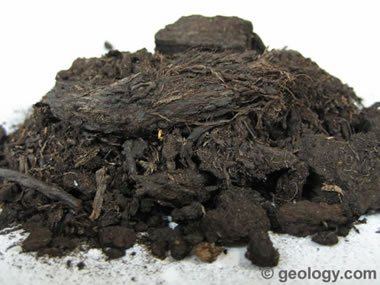
Peat: A mass of recently accumulated to partially carbonized plant debris. This material is on its way to becoming coal, but its plant debris source is still easily recognizable.
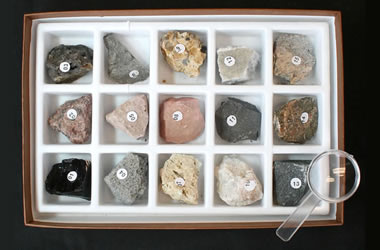
Rock & Mineral Kits: Get a rock, mineral, or fossil kit to learn more about Earth materials. The best way to learn about rocks is to have specimens available for testing and examination.
How Does Coal Form?
Coal forms from the accumulation of plant debris, usually in a swamp environment. When a plant dies and falls into the swamp, the standing water of the swamp protects it from decay. Swamp waters are usually deficient in oxygen, which would react with the plant debris and cause it to decay. This lack of oxygen allows the plant debris to persist. In addition, insects and other organisms that might consume the plant debris on land do not survive well under water in an oxygen-deficient environment.
To form the thick layer of plant debris required to produce a coal seam, the rate of plant debris accumulation must be greater than the rate of decay. Once a thick layer of plant debris is formed, it must be buried by sediments such as mud or sand. These are typically washed into the swamp by a flooding river. The weight of these materials compacts the plant debris and aids in its transformation into coal. About ten feet of plant debris will compact into just one foot of coal.
Plant debris accumulates very slowly. So, accumulating ten feet of plant debris will take a long time. The fifty feet of plant debris needed to make a five-foot thick coal seam would require thousands of years to accumulate. During that long time, the water level of the swamp must remain stable. If the water becomes too deep, the plants of the swamp will drown, and if the water cover is not maintained the plant debris will decay. To form a coal seam, the ideal conditions of perfect water depth must be maintained for a very long time.
If you are an astute reader you are probably wondering: "How can fifty feet of plant debris accumulate in water that is only a few feet deep?" The answer to that question is the primary reason that the formation of a coal seam is a highly unusual occurrence. It can only occur under one of two conditions: 1) a rising water level that perfectly keeps pace with the rate of plant debris accumulation; or, 2) a subsiding landscape that perfectly keeps pace with the rate of plant debris accumulation. Most coal seams are thought to have formed under condition #2 in a delta environment. On a delta, large amounts of river sediments are being deposited on a small area of Earth's crust, and the weight of those sediments causes the subsidence.
For a coal seam to form, perfect conditions of plant debris accumulation and perfect conditions of subsidence must occur on a landscape that maintains this perfect balance for a very long time. It is easy to understand why the conditions for forming coal have occurred only a small number of times throughout Earth's history. The formation of a coal requires the coincidence of highly improbable events.
Rank (From Lowest to Highest) |
Properties |
Peat |
A mass of recently accumulated to partially carbonized plant debris. Peat is an organic sediment. Burial, compaction, and coalification will transform it into coal, a rock. It has a carbon content of less than 60% on a dry ash-free basis. |
Lignite |
Lignite is the lowest rank of coal. It is a peat that has been transformed into a rock, and that rock is a brown-black coal. Lignite sometimes contains recognizable plant structures. By definition it has a heating value of less than 8300 British Thermal Units per pound on a mineral-matter-free basis. It has a carbon content of between 60 and 70% on a dry ash-free basis. In Europe, Australia, and the UK, some low-level lignites are called "brown coal." |
Sub Bituminous |
Sub bituminous coal is a lignite that has been subjected to an increased level of organic metamorphism. This metamorphism has driven off some of the oxygen and hydrogen in the coal. That loss produces coal with a higher carbon content (71 to 77% on a dry ash-free basis). Sub bituminous coal has a heating value between 8300 and 13000 British Thermal Units per pound on a mineral-matter-free basis. On the basis of heating value, it is subdivided into sub bituminous A, sub bituminous B, and sub bituminous C ranks. |
Bituminous |
Bituminous is the most abundant rank of coal. It accounts for about 50% of the coal produced in the United States. Bituminous coal is formed when a sub bituminous coal is subjected to increased levels of organic metamorphism. It has a carbon content of between 77 and 87% on a dry ash-free basis and a heating value that is much higher than lignite or sub bituminous coal. On the basis of volatile content, bituminous coals are subdivided into low-volatile bituminous, medium-volatile bituminous, and high-volatile bituminous. Bituminous coal is often referred to as "soft coal"; however, this designation is a layman's term and has little to do with the hardness of the rock. |
Anthracite |
Anthracite is the highest rank of coal. Unlike other types of coal, it is usually considered to be a metamorphic rock. It has a carbon content of over 87% on a dry ash-free basis. Anthracite coal generally has the highest heating value per ton on a mineral-matter-free basis. It is often subdivided into semi-anthracite, anthracite, and meta-anthracite on the basis of carbon content. Anthracite is often referred to as "hard coal"; however, this is a layman's term and has little to do with the hardness of the rock. |
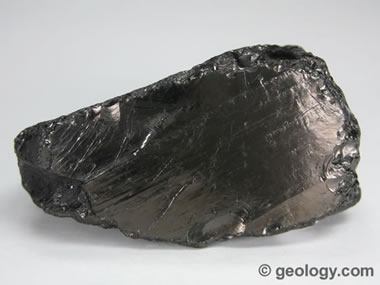
Anthracite coal: Anthracite is the highest rank of coal. It has a bright luster and breaks with a semi-conchoidal fracture.
What is Coal "Rank"?
Plant debris is a fragile material compared to the mineral materials that make up other rocks. As plant debris is exposed to the heat and pressure of burial, it changes in composition and properties. The "rank" of a coal is a measure of how much change has occurred. Sometimes the term "organic metamorphism" is used for this change.
Based upon composition and properties, coals are assigned to a rank progression that corresponds to their level of organic metamorphism. The basic rank progression is summarized in the table here.
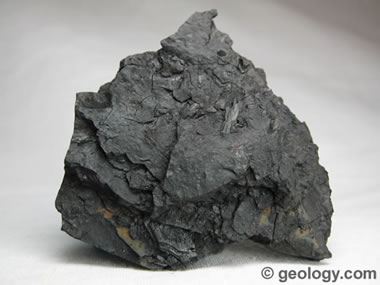
Lignite: The lowest rank of coal is "lignite." It is peat that has been compressed, dewatered, and lithified into a rock. It often contains recognizable plant structures.
What are the Uses of Coal?
Electricity production is the primary use of coal in the United States. Most of the coal mined in the United States is transported to a power plant, crushed to a very small particle size, and burned. Heat from the burning coal is used to produce steam, which turns a generator to produce electricity. Most of the electricity consumed in the United States is made by burning coal.
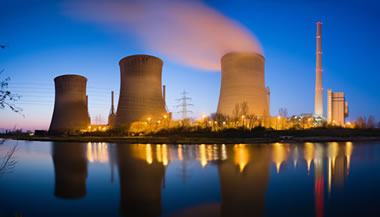
Coal-Fired Power Plant: Photo of a power plant where coal is burned to produce electricity. The three large stacks are cooling towers where water used in the electricity generation process is cooled before reuse or release to the environment. The emission streaming from the right-most stack is water vapor. The combustion products from burning the coal are released into the tall, thin stack on the right. Within that stack are a variety of chemical sorbents to absorb polluting gases produced during the combustion process. Image copyright iStockphoto / Michael Utech.
Coal has many other uses. It is used as a source of heat for manufacturing processes. For example, bricks and cement are produced in kilns heated by the combustion of a jet of powdered coal. Coal is also used as a power source for factories. There it is used to heat steam, and the steam is used to drive mechanical devices. A few decades ago most coal was used for space heating. Some coal is still used that way, but other fuels and coal-produced electricity are now used instead.
Coke production remains an important use of coal. Coke is produced by heating coal under controlled conditions in the absence of air. This drives off some of the volatile materials and concentrates the carbon content. Coke is then used as a high-carbon fuel for metal processing and other uses where an especially hot-burning flame is needed.
Coal is also used in manufacturing. If coal is heated the gases, tars, and residues produced can be used in a number of manufacturing processes. Plastics, roofing, linoleum, synthetic rubber, insecticides, paint products, medicines, solvents, and synthetic fibers all include some coal-derived compounds. Coal can also be converted into liquid and gaseous fuels; however, these uses of coal are mainly experimental and done on a small scale.
| More Rocks |
 |
Tumbled Stones |
 |
Fossils |
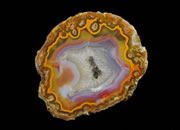 |
Geodes |
 |
The Rock Used to Make Beer |
 |
Topo Maps |
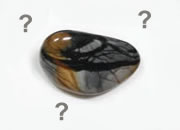 |
Difficult Rocks |
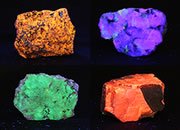 |
Fluorescent Minerals |
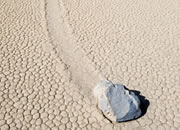 |
Sliding Rocks on Racetrack Playa |

Find Other Topics on Geology.com:

|

| ||

|

| ||

|

| ||

|

|
